What is CCTV?
CCTV surveillance is also known as video surveillance because it is a type of closed-circuit television. A closed-circuit broadcast typically reaches a limited number of monitors, as opposed to “regular” TV, which is intended for the general public. It is common to use CCTV networks to detect and deter criminal activity, and also to record traffic infractions, but they have other uses as well.
Monitoring CCTV Surveillance Networks
Network monitoring software is one of the fastest-growing trends in CCTV security. It ensures that CCTV systems run smoothly and can provide 24/7 monitoring and notifications of an area. Monitoring systems can alert staff when there is a power outage (and automatically switch to a backup power source), it continuously monitors the network for unusual activity, and be configured based on various usage types, risks, and requirements (e.g. medical or retail).
Types of CCTV surveillance systems
Analog
Continually transmit video signals using Bayonet Neill-Concelman (BNC) connectors on coaxial cables. Although low resolution, they are inexpensive and effective. Analog systems have more peripheral components, such as coaxial cables that don’t usually transmit audio. Digitizing analog signals makes going digital more cost-effective even with old equipment. You can record the images on a PC or tape recorder with a video capture card. With analog HD, you get a higher resolution than traditional systems (1080 pixels) and backward compatibility with analog cameras and BNC.
Digital
Signals should be digitalized at the camera level. Since videos are stored directly on the computer, these systems don’t require a video capture card, but they do require a large amount of storage to store the recordings, so they are usually heavily compressed.
Network or IP
These systems allow users to stream footage from analog or digital cameras via an online video server, utilizing analog or digital cameras. The advantages of this system include WiFi and audio capabilities in addition to Distributed Artificial Intelligence (DAI) for analyzing image footage, remote access, Power Over Ethernet (POE), and better resolution.
As well as the fact that IP cameras contain more cameras in one, which can cover a wider angle than a single camera or camera system would normally cover, there is also the fact that IP cameras are smaller and more reliable

